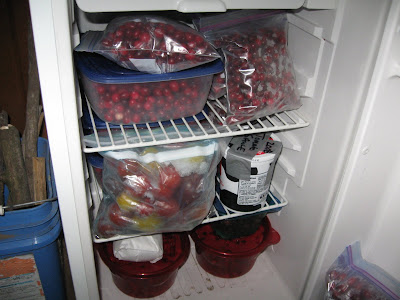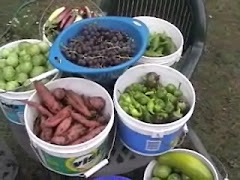The root cellar is our basement, we are lucky to live in an early 1900's cottage type house with a large cement basement that stays fairly cool year around. We keep potatoes,

carrots, beets,

kohlrabi, cabbage,

Belgian endive,

parsnips, turnips, apples, celery in the root cellar because the temperature and humidity is just about right for these crops. Squash,

onions,

and some of the tomatoes,


tomatillos, peppers,

eggplants are all kept in various parts of the house as it is less humid and has a more varied temperature range. Some of the tomatoes (Burpee Long Keeper) last all the way until spring if we are lucky. We also bring some pepper plants live in pots into the house in order to have peppers all the way into December.
We dry apples, pears, plums, tomatoes, walnuts, herbs, garlic, morel mushrooms, and beans.


Some are dried in the greenhouse and porch, but we do rely upon a food dryer for most of them as we have a very humid fall in our area that is not conducive to drying food.
The only herbs we freeze are basil and cilantro. We pick them, wash and dry the leaves as necessary, mix in a big bowl with a little olive oil and then pack them into freezer bags. This seems to make them keep better and allows us to easily separate the frozen leaves as needed. Tomatoes, tomatillos, ground cherries, and peppers are also frozen or made into sauce. Broccoli, beet greens, kale, garlic scapes and basil are made into a pesto and served over pasta. We also freeze some of the kale and use it in soups...it really freezes well and is an excellent addition to soups, omelets, or stir fry.
We freeze most of our berries

but are looking for alternatives to this as the berries make up about 60% of our freezer space. We had to use these two smaller freezers as a backup because our big one overfloweth, I suppose this is a good problem though , it's better to worry about not having enough space than not having enough stuff to fill my spaces.

If anyone has come up with a way to store berries in their natural state we would love to hear about it. We use them in smoothies for breakfast and would love to do away with freezing them but don't want the added sugar that canning would involve.
Below is a list I made several years ago to remind me not to forget any of my fall duties. The dates change according to the weather.
HARVEST SCHEDULE:
7/1 - 10/1- dry or freeze (basil & cilantro) herbs and make basil, broccoli pesto
9/01- pull beans for drying in greenhouse
9/15-25 - pull tomatoes (tomatoes in house for quick ripen and basement for slow ripen) and most peppers, tomatillos, ground cherries, and eggplants, pot up peppers to overwinter
9/15-25 - pick summer squash, check pear trees
9/25-10/1- pull and dry on porch, potatoes, winter squash, zucchini, cabbage, kohlrabi ( cabbage kohlrabi only if fearing frost, best to wait as long as possible) (remember that last November got really warm and I pulled cabbage, kohlrabi and potatoes to soon)
9/26-10/20- pick plums
10/1- get row covers ready
10/15-11/15- pot up for forcing, beets, dandelions, Belgian endive (do endive last), broccoli, cabbage plants, asparagus, parsley, and chard ...remember to bury extra greens in bags for the chickens
10/30-11/30- pot up rhubarb ( allow to frost for 3 weeks before bringing in ...see plant notes on forcing rhubarb)
10/1/-10/30- apples and cranberries
10/15- 11/01- pull carrots, pot up leeks, clean garden and greenhouse
11/01-11/15- cut back raspberry and grape vines























8 comments:
Hi Mr and Mrs H
I'm enjoying reading about your life on the other side of the world.
Have you tried drying the berries?
It is possible to 'can' (we call it bottling over here) fruit in water or fruit juice so you don't need to add sugar This is a link for more info
Scarecrow,
Isn't the internet great. Thank you so much for the link on canning. I did not realize that one could bottle fruit without sugar. We do dry some of our berries, but have problems with humidity. I am looking into useing our barn roof as a giant dryer this summer. Thanks
Mr. H
A friend of mine here cans the berries sans sugar and says they turn out wonderfully. I've not tried it and am still dependent upon my freezer for the berries. I may try canning some of the harvest this year.
Readingthrough your blog, and wanted mention something in regards to berries.
I'm assuming you have a root cellar?
Nourishing traditions, and I think Wild Fermentation discuss this.
Lacto fermented berries and fruits have along shelf life when kept at around 40 degrees. Root cellar is ideal for this, as one would need a seperate fridge to do this well.
They also retain there freshness.
Tasting the same as if they were freshly picked.
No heat is used, so all the good is retained, plus the extra probitocs that are added in the fermentation process.
We also make lacto fermetned saurkraut and kimchi this way.
Far superior product over the newer methods that add canning/killing.
Paula
Thank you Steve and Paula,
This is exactly the type of information I was looking for... perfect timing.
Mike
Have you tried making fruit leather? I blend the fruit in a blender then pour it onto plastic wrap and put it in the dehydrator. When done I just wrap it in the same plastic. Sometimes I'll add agave and lemon juice. The kids LOVE it!
I'm not sure how it would blend up in a smoothie.
Do you eat dairy products? We have Nigerian Dwarf goats. They don't produce as much as the larger goats plus they eat less. I get up to a quart a day per doe. That's enough for our milk needs. Vinegar ricotta cheese is easy. I just recently tried putting this ricotta cheese in with olive oil and lemon juice and lemon basil...yummy.
Anonymous - Hello, we do make lots of fruit leather and enjoy eating it during the winter months or while out hiking.
We do not have goats...yet. I have been considering delving into that area of animal husbandry in the future. The vinegar ricotta cheese sounds delicious.:)
absolutely gorgeous!
Post a Comment